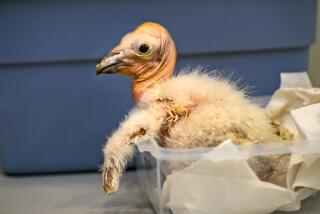Ban on hunting with lead ammunition is expanded
A ban on hunting with lead ammunition within the California condor’s 2,385-square-mile range will be expanded to prohibit its use in the shooting of small nuisance animals, according to a settlement announced Wednesday between environmentalists and state wildlife authorities.
The Condor Preservation Act already forbids lead for killing big game such as deer, antelope, bear and bighorn sheep, and non-game species such as feral pigs and coyotes within their range. The settlement reached by the Natural Resources Defense Council, Center for Biological Diversity and California Department of Fish and Game aimed to clarify rules regarding shooting of smaller pests.
Of particular concern, Fish and Game a year ago announced a new policy requiring that all permits issued for shooting nuisance animals in condor territory include a requirement for using non-toxic ammunition. But the department’s regulatory arm, the California Fish and Game Commission, had not yet changed state regulations regarding allowable ammunition for such depredation killings.
Under terms of the settlement, the commission has agreed to consider prescribing a similar regulation against using the toxic metal for hunting of small mammals such as rabbits, opossums and tree squirrels, said Adam Keats, a spokesman for the Center for Biological Diversity. “With this settlement, which still requires court approval, we’ve tied up the remaining loose ends in state hunting laws when it comes to toxic ammo in condor country,” Keats said.
Scientists have determined that lead poisoning from bullets is one of the leading killers of the majestic scavengers, which ingest the toxic heavy metal while feasting on the carcasses of hunted animals and gut piles in their territory.
Exposure to lead was cited as a key factor in the near extinction of the vulture-like bird with a 9 1/2 -foot wingspan. By the time all the wild condors were rescued in the 1980s for a captive breeding program, only a few dozen remained.
Some biologists, however, believe that the ban on lead does not go far enough. “Until the supply of lead ammunition is completely choked off, it will be really hard to ensure the safety of condors,” said Noel Snyder, a retired field biologist for the U.S. Fish and Wildlife Service. “That is because lead will continue to come in as people hunt around the edges of their territory.”
--
More to Read
Sign up for Essential California
The most important California stories and recommendations in your inbox every morning.
You may occasionally receive promotional content from the Los Angeles Times.











